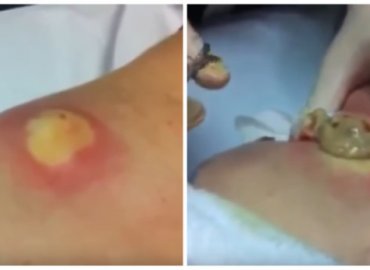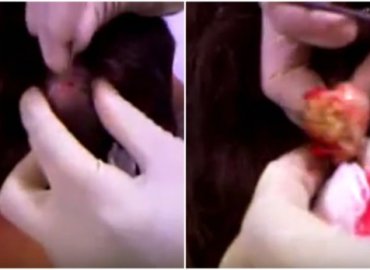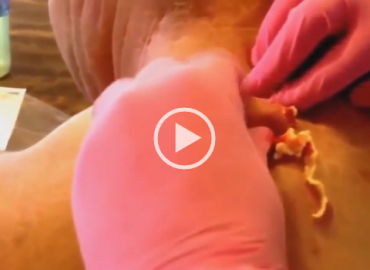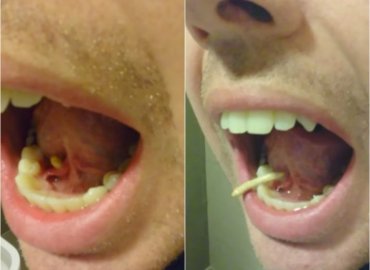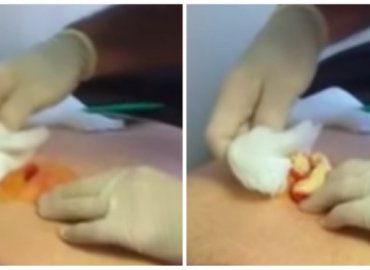TRIPURA, INDIA- SEPTEMBER, 16, 2017: Two-year-old Jailian Kaipeng pictured at his residence in Tripura, India.nnJailian Kaipeng’s eyes swelled to the size of lemons due to a rare genetic disorder called Orbital Pseudotumour. Jalien¿s condition pushes his eyes forward to the extent that the lids cannot cover and protect the cornea. The parents of the toddler couldn’t afford big hospitals and now hope for a miracle to cure their child.nnPhotography by: Cover Asia Press / Bapi Debnath
These heartbreaking pictures reveal the plight of a two-year-old boy with protruding eyes who is slowly losing his eye sight because his parents are too poor to afford medical treatment.
Jailian Kaipeng is in ‘constant pain’ and may be suffering from a rare disorder that inflames his eyes or even a type of children’s eye cancer.
But there is little hope of his suffering being alleviated because his labourer father earned just Rs 150 (£1.70) a day and is now jobless.
Jailian was born a healthy baby but his eyes began to swell when he was just two months old. His condition now pushes his eyes forward so much that the lids of his eyes cannot even close.
His mother Chengmaite, 25, from a remote village in Tripura, north eastern India, said: ‘All the doctors have said we should take him to the big hospitals but they are beyond our affordability.
‘People stare at him and are shocked by his condition which breaks my heart. All we can do it wait for a miracle to happen. We are in desperate need of help.’
Scroll down for videoLocal doctors are baffled
Jailian’s father, Neirbanglal Kaipeng, 28, said explained that his son’s right eye started swelling a couple of months after his birth.
‘A red line would appear and disappear on his eye ball and it would cause his eye to swell,’ he said.
‘We were very shocked when we first saw it, we had no idea what to do, or who to turn to.’
The family consulted local doctors but none could diagnose his condition.
‘We took him to see our local doctors,’ Neirbanglal said. ‘But they were baffled. They gave him some medicines and sent us home but his eyes just got worseEventually the condition spread to his left eye and the swelling became permanent.
For the last two years his parents have watched helplessly as their baby’s condition worsened.
It is suspected that Jailian may have orbital pseudotumour, which is the inflammation of the eye muscles or even worse he has a type of eye cancer called retinoblastoma.
Bu without consultations with experts and tests, no one can be sure.
We sat there staring and crying
In desperation Neirbanglal sold some of his land for Rs 30,000 (£340) and the family cow for Rs 10,000 (£110) to pay for further consultation fees, travel expenses and medicines.
But Jailian’s condition continued to worsen and the family have not been able to afford the best care – and have now lost their home.
‘We were shocked and helpless by the visibility of his condition. I had no idea where to take my son,’ said Neirbanglal.
‘We do not have that kind of knowledge or know how best to help him.
‘We had no money to take him to the city hospitals. But we wasted time, just sitting and staring at him all day, crying.
‘And in that time we could see his eyes getting worse.’
Eventually, the family – including Jailian’s brother Ringdamte, 10, and nine-month-old sister Naote – had to leave their rented accommodation and move in with Chengmaite’s parents.
This child needs immediate attention’
A nearby Christian Missionary helped the family see a doctor in July who diagnosed his condition as orbital pseudotumour.
But no treatment was carried out and experts say the boy needs a second opinion and a biopsy to rule out cancer.
Neirbanglal said: ‘There’s a Christian missionary near my in-laws’ house so we asked them for help and they kindly found us a good doctor.
‘The doctor has given my son’s disease a name but he’s done nothing else because we have no money. We have no idea what it is, whether it can be cured or what to do next, we’ve had no guidance.
‘I have no idea how long we can stay here. I am now jobless as we’ve had to move home.
‘My wife is always crying. We can’t sleep for worrying about him. It has started affecting our health too.’
Dr Shashidhar Tatavarthy, a paediatric at Artemis Hospital, in Delhi, said: ‘We need to do a biopsy immediately to confirm the condition and differentiate it from a malignant tumour.
‘The boy has not lost his sight yet but if he’s left untreated any longer he could lose his sight completely.
‘It is extremely rare to have this condition in a child of two years old. Surgery would be very complex but essential. This child needs immediate attention and treatment.’
Neirbanglal added: ‘It is devastating to see my child suffering like this. He cannot see properly and it kills me to see him like this.
‘I am possibly the most useless father who is not able to help his son.’
Distinguish between a sebaceous cyst and epidermoid cyst. An epidermoid cyst is more common than a sebaceous cyst. Each will have slightly different symptoms and will be treated just a little differently. Therefore, it is important that the cyst you have on your skin is diagnosed appropriately for effective treatment.
Both types of cysts are flesh-colored or white-yellow and have a smooth surface.
Epidermoid cysts are more common. These are slow growing and often painless. They don’t usually require treatment, unless they are causing pain or become infected.
Pilar cysts are composed primarily of keratin (the protein that makes up hair and nails) and form from the outer hair root sheath, typically on the head. A pilar cyst is often thought to be another term for a sebaceous cysts, but they are in fact different.
Sebaceous cysts are commonly found in the hair follicles on the head. They form inside the glands that secrete sebum, an oily substance that coats the hair. When these normal secretions are trapped, they develop into a pouch containing a cheese-like substance. They are commonly found in areas near the neck, upper back, and on the scalp. Sebaceous cysts are often confused with pilar or epidermoid cysts.
Distinguish between cysts in the breast and tumors. Cysts can be in one or both breasts. Without a mammogram or needle biopsy it is almost impossible to distinguish between the two different types of lumps in the breast. Symptoms of a breast cyst will include:
Smooth, easily movable lump with distinct edges
Pain or tenderness over the lump
Size and tenderness will increase just before your period starts
Size and tenderness will decrease when your period ends
Understand cystic acne. Acne is a general term that describes a variety of different types of pimples, blackheads, pustules, whiteheads and cysts. Cystic acne are nodules that are red, raised, often 2–4 mm in size and nodular and are the most severe form of acne. The infection in a cystic acne is deeper than that in other pustules or whiteheads. Cystic acne is painful.
Identify a ganglion cyst. These are the most common types of lumps found on the hand and wrist. They are not cancerous and often harmless. Filled with fluid, they can quickly appear, disappear or change in size. They do not require treatment unless they interfere with function or are unacceptable in appearance.
Determine if pain is from a pilonidal cyst. In this condition there is a cyst, abscess or dimple that forms in the crease between the buttocks that runs from the lower end of the spine to the anus. It can be caused from wearing tight clothing, excess body hair, sitting for long periods of time or obesity. Symptoms can include pus from the area, tenderness over the cyst, or the skin may be warm, tender or swollen near the tailbone. Or there may not be any symptoms beside a pit or dimple at the base of the spine.
Distinguish a Bartholin gland cyst. These glands are located on either side of the vaginal opening to lubricate the vagina. When the gland becomes obstructed, a relatively painless swelling forms called a Bartholin’s cyst. If the cyst is not infected you may not notice it. An infection can occur in a matter of days causing tenderness, fever, discomfort walking, pain with intercourse, and a tender, painful lump near the vaginal opening.
See a doctor for swelling in the testicles. All testicular swelling must be diagnosed by a physician to determine the differences between a cyst, cancerous growth, hydrocele or infection in the testicles. A testicular cysts, also called a spermatocele or epididymal cyst, is typically a painless, fluid-filled, noncancerous sac in the scrotum above the testicles. T
Consider getting a second opinion if you are not satisfied with your physician’s diagnosis and treatment. Although most epidermoid and pilar cysts do not require treatment from a physician, if you do seek medical advice and are not satisfied with the results seek a second opinion. Most sebaceous and epidermoid cysts are straightforward, but there are other conditions that may mimic these cysts.
In a case study written in the Royal College of Surgeons of England, the authors presented two cases in which melanoma and a deep oral cavity were originally mistaken for a sebaceous cyst.
There are a variety of other infectious processes that may be mistaken for a sebaceous cyst, including boils, furuncles and carbuncles.
Treating a Cyst at Home
Treat uninfected epidermoid and sebaceous cysts at home. Signs of infection include the area becoming swollen, red, tender, or red and warm. If your home treatment for these cysts is not effective or if you experience symptoms, which indicate an infection, you should seek medical care from your physician.
If the cyst causes pain or discomfort with walking or intercourse, medical care is needed to treat the cyst.
Use a wet, warm compress over an epidermoid cyst to encourage it to drain and heal. The washcloth should be hot but not so hot that it burns the skin. Place it over the cyst two to three times a day.
Cystic acne responds better to ice than it does to heat.
Bartholin gland cysts can be treated at home using warm water sitz baths. This involves sitting in several inches of warm water to encourage the cyst to drain.
Refrain from picking, squeezing, or trying to pop either an epidermoid cyst or sebaceous cyst. This can increase the risk of infection and scarring. Also, never pick, squeeze or attempt to pop a cystic acne. This drives the infection deeper and increases the risk of scar tissue.
Allow an epidermoid cyst to drain naturally. Once it begins to drain, cover it with a sterile dressing, which you can change twice a day. If a large amount of pus begins to drain from the cyst, the skin surrounding the cyst turns red, the area becomes warm and tender, or blood begins to drain from the cyst, it is time to seek medical care.
Keep the area clean. To prevent an infection, keep the cyst and the area surrounding it clean. Wash it daily using an antibacterial soap or cream.
Cysts are fluid-filled pockets that form on the skin. While not usually dangerous, they can be painful and annoying. Depending on the type of cyst, you can usually have a cyst medically removed with the assistance of a doctor.
Dealing with Facial Cysts
Decide if medical intervention is necessary. Facial cysts, medically referred to as sebaceous cysts, can be annoying and unsightly but they don’t necessarily require medical intervention. If the cyst is not painful, it might be best to leave it alone to avoid complications having it removed. However, you should see a doctor if any of the following develop:
-Facial cysts are usually small, round lumps just underneath the skin. They may be black, reddish or yellowish, and occasionally release foul-smelling discharge. Cysts are generally more painful than other skin conditions, such as pimples.
-If the cyst ruptures, this can lead to a potentially dangerous boil-like infection. Prompt treatment and removal is required.
-If the cyst suddenly becomes painful and swollen, it may be infected. See a doctor to get the cyst removed and get the proper antibiotics.
-In very rare cases, a cyst can lead to skin cancer. During your regular annual doctor’s exam, ask your doctor to look at the cyst and determine if it poses a risk for cancer.
Dealing with Facial Cysts
Ask your doctor for an injection. If the cyst is infected or painful, your doctor can inject the cyst with a medication. While this will not fully remove the cyst, it will reduce redness and swelling. This can make the cyst less noticeable.
Have the cyst drained. If the cyst grows significantly or becomes painful and uncomfortable, you can have it medically removed. The cyst can be cut open and drained by your doctor.
– The doctor will make a small cut in the cyst and gently drains out the built up fluid. The procedure is fairly quick and usually not painful.[6]
– The major downside to this method is that cysts often reoccur after being lanced and drained.
Ask about surgery. The only way to fully remove a cyst is through surgery. Talk to your doctor about undergoing surgery if you want a cyst removed.
– Cyst removal surgery is minor. It does not take very long and recovery time is relatively brief. However, you may have to return to your doctor’s office after the surgery to remove any stitches.
– Surgery is very safe and usually prevents cysts from occurring. However, cysts do not usually pose a medical threat. Therefore it may be difficult to get surgery covered by insurance.


